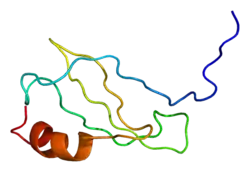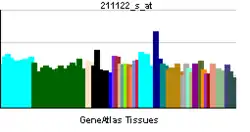CXCL11
CXCL11(英語:)是一小分子的细胞因子属于CXC趋化因子家族[1],又被称作“干扰素诱导的T细胞a趋化因子”(Interferon-inducible T-cell alpha chemoattractant (I-TAC)[1]。
| Chemokine (C-X-C motif) ligand 11 | |||||||||||||
|---|---|---|---|---|---|---|---|---|---|---|---|---|---|
 PDB rendering based on 1rjt. | |||||||||||||
| |||||||||||||
| 标识 | |||||||||||||
| 代号 | CXCL11; H174; I-TAC; IP-9; IP9; SCYB11; SCYB9B; b-R1 | ||||||||||||
| 扩展标识 | 遗传学:604852 鼠基因:1860203 同源基因:3944 GeneCards: CXCL11 Gene | ||||||||||||
| |||||||||||||
| RNA表达模式 | |||||||||||||
 | |||||||||||||
 | |||||||||||||
| 更多表达数据 | |||||||||||||
| 直系同源体 | |||||||||||||
| 物种 | 人类 | 小鼠 | |||||||||||
| Entrez | 6373 | 56066 | |||||||||||
| Ensembl | ENSG00000169248 | n/a | |||||||||||
| UniProt | O14625 | Q9JHH5 | |||||||||||
| mRNA序列 | NM_005409 | NM_019494.1 | |||||||||||
| 蛋白序列 | NP_005400 | NP_062367.1 | |||||||||||
| 基因位置 |
Chr 4: 76.95 – 76.96 Mb | n/a | |||||||||||
| PubMed查询 | |||||||||||||
表达
在白细胞,胰腺和肝脏中表达水平高,在胸腺,脾和肺有中等水平的表达,在小肠,胎盘和前列腺中表达水平低[1]。干扰素伽玛和干扰素-b可以在单核细胞[1],支气管上皮细胞[2],中性粒细胞[3],角质形成细胞[4],和内皮细胞诱导CXCL11的表达。
功能
CXCL11对活化的T细胞,中性粒细胞和单核细胞有细胞趋化作用[1]。
参考文献
- Cole et al. Interferon-inducible T cell alpha chemoattractant (I-TAC): a novel non-ELR CXC chemokine with potent activity on activated T cells through selective high affinity binding to CXCR3. J. Exp. Med. 187: 2009-2021, 1998.
- Sauty, A., Dziejman, M., Taha, R. A., Iarossi, A. S., Neote, K., Garcia-Zepeda, E. A., Hamid, Q., Luster, A. D. (1999) The T cell-specific CXC chemokines IP-10, MIG, and I-TAC are expressed by activated human bronchial epithelial cells J. Immunol. 162,3549-3558
- Gasperini, S., Marchi, M., Calzetti, F., Laudanna, C., Vicentini, L., Olsen, H., Murphy, M., Liao, F., Farber, J., Cassatella, M. A. (1999) Gene expression and production of the monokine induced by IFN-gamma (MIG), IFN-inducible T cell alpha chemoattractant (I-TAC), and IFN-gamma-inducible protein-10 (IP-10) chemokines by human neutrophils J. Immunol. 162,4928-4937.
- Tensen, C. P., Flier, J., Van Der Raaij-Helmer, E. M., Sampat-Sardjoepersad, S., Van Der Schors, R. C., Leurs, R., Scheper, R. J., Boorsma, D. M., Willemze, R. (1999) Human IP-9: a keratinocyte-derived high-affinity CXC-chemokine ligand for the IP-10/MIG receptor (CXCR3) J. Invest. Dermatol. 112,716-72.
- Loetscher M, Gerber B, Loetscher P, Jones SA, Piali L, Clark-Lewis I, Baggiolini M, Moser B. Chemokine receptor specific for IP10 and mig: structure, function, and expression in activated T-lymphocytes. J Exp Med. 1996 Sep 1;184(3):963-9.
- Weng Y, Siciliano SJ, Waldburger KE, Sirotina-Meisher A, Staruch MJ, Daugherty BL, Gould SL, Springer MS, DeMartino JA. Binding and functional properties of recombinant and endogenous CXCR3 chemokine receptors. J Biol Chem. 1998 Jul 17;273(29):18288-91.
- Loetscher P, Pellegrino A, Gong JH, Mattioli I, Loetscher M, Bardi G, Baggiolini M, Clark-Lewis I. The ligands of CXC chemokine receptor 3, I-TAC, Mig, and IP10, are natural antagonists for CCR3. J Biol Chem. 2001 Feb 2;276(5):2986-91
外部链接
This article is issued from Wikipedia. The text is licensed under Creative Commons - Attribution - Sharealike. Additional terms may apply for the media files.